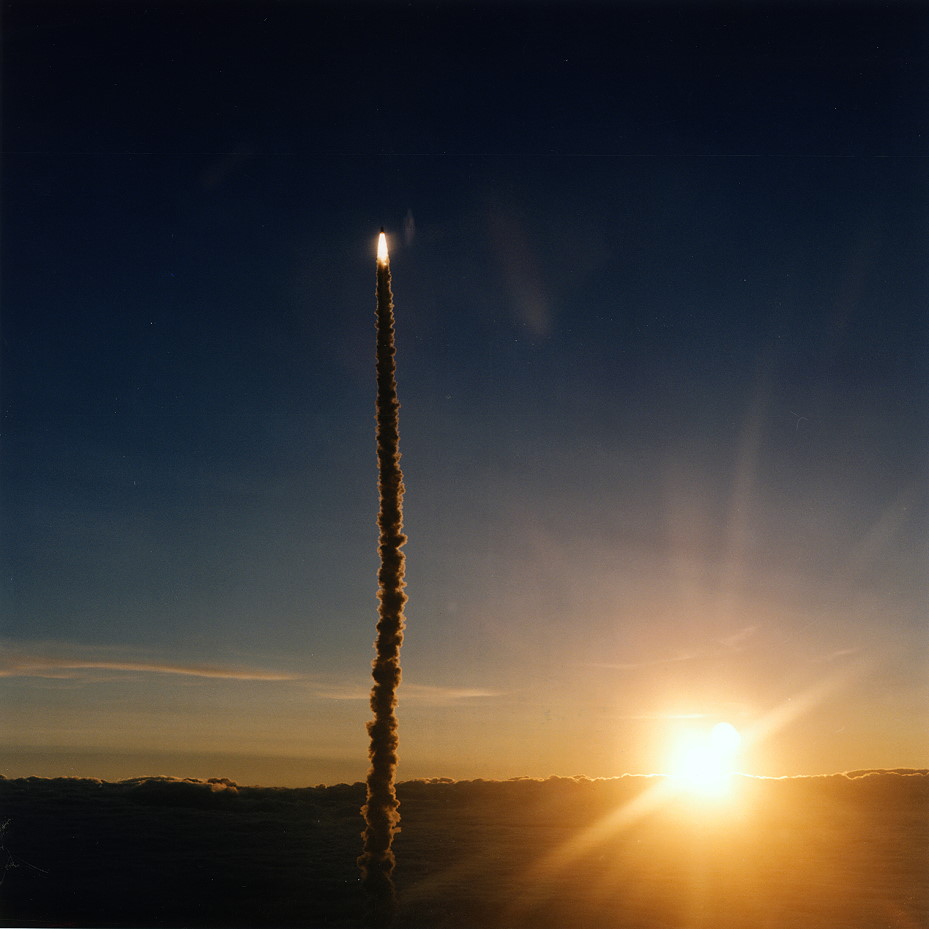
With seven space missions, two EVAs, and almost 200 cumulative days in orbit between them, two of NASA’s best and brightest astronauts have departed the agency for pastures new. Dave Leestma, a veteran the first U.S. spacewalk to feature a woman astronaut, and Andy Thomas, a member of the first post-Columbia shuttle crew, can also count a grant total of 66 years of federal service between them. These men participated in several key missions which helped establish the credentials of the shuttle program, develop the partnership with the Russians, build the International Space Station (ISS), and chart a roadmap for NASA’s exploration efforts of the future.
“From the day we came together as astronaut candidates, Dave stood out as a remarkable leader, friend and loyal team-mate,” said former astronaut and incumbent NASA Administrator Charlie Bolden in a statement yesterday (Wednesday, 18 June). “He possessed seemingly infinite wisdom of the space shuttle and all its systems and never ceased to amaze me with his performance. We wish him the best.” It was praise indeed for Leestma, who became the first member of his May 1980 astronaut class to draw a flight assignment and board a shuttle for the heavens. It was reportedly Leestma who wryly dubbed his 19-strong class “The Needless Nineteen.” “We earned that nickname because there were 35 ahead of us, plus all the other astronauts that were there from the Apollo days that either hadn’t flown or were still there,” Leestma reflected in a NASA oral history, “and they were all waiting to fly the shuttle, so we were way down the line.”
David Cornell Leestma came from Muskegon, Mich., where he was born on 6 May 1949. He attended high school in California and entered the U.S. Naval Academy to study aeronautical engineering, graduating first in his class in 1971 and receiving assignment to the frigate U.S.S. Hepburn. Almost immediately, however, he was ordered to report to the Naval Postgraduate School for a master’s degree, also in aeronautical engineering. Leestma then moved into flight school, received his aviator’s wings in October 1973, and underwent training on the F-14 Tomcat fighter. During the next several years of his military career, he participated in three overseas deployments to the Mediterranean and North Atlantic, flying from the U.S.S. John F. Kennedy, and in 1977 was sent to Naval Air Station Point Mugu, Calif., as part of the air testing and evaluation squadron. Leestma served as an operational test director on the Tomcat, with a specific focus upon the development of new tactical software and programmable signal processors.
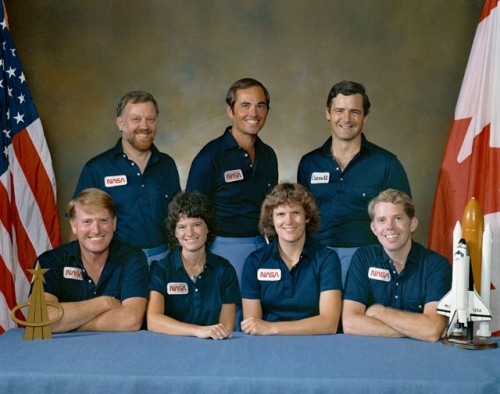
Whilst aboard the John F. Kennedy, his operations officer advised him to apply for NASA’s 1978 astronaut class—and even sent off for the application pack on his behalf—but Leestma was too busy with his other duties and put such thoughts to one side. By the end of 1978 he was back on shore duty, and when the space agency announced its intention to select more astronauts, he dusted off his original application and submitted. He was summoned to the Johnson Space Center (JSC) in Houston, Texas, part of the very first group to be interviewed, in February 1980, and heard no more for several months. “And then, in late May of 1980, I got this call, early in the morning,” he told the NASA oral historian. “I was in California, so it was two hours earlier than here [in Houston]. As I found out later, they start calling around eight o’clock in the morning and it was around six-thirty or something … and it was George Abbey on the phone. Now, I didn’t know that if George calls you, then you’re in, and if somebody else calls you on the board, then you’re not in!”
In spite of the “Needless Nineteen” moniker, Leestma was excited by the enormity of the astronaut business. On one training trip, he found himself on a commercial airliner, seated next to Al Bean, who regaled him with tales of his experiences on the Moon during Apollo 12. “The stewardess came by and served us our Cokes,” Leestma recalled, “and she doesn’t have a clue who she just talked to! This man next to me walked on the Moon!” However, his own experience assured him that a flight assignment would not come along for some considerable time; by the summer of 1983, barely half of the astronaut class in front of the Nineteen had been named to missions. Leestma knew that he would have a long wait.
That was until a chance telephone call from George Abbey, one Saturday morning, telling Leestma to come into work. When he arrived, he found astronauts Bob Crippen, Jon McBride, Sally Ride, and Kathy Sullivan and was told of his selection as a Mission Specialist on STS-17, planned for launch in October 1984. Several shuttle flights were subsequently pushed back on the manifest, but STS-17—later renamed “41G”—kept its cargo and kept its place on the launch schedule, primarily due to its unique payloads: the Earth Radiation Budget Satellite (ERBS) and a pallet of experiments from NASA’s Office of Space and Terrestrial Applications (OSTA)-3.
“So I ended up flying quite a bit earlier than the other people in my class,” Leestma said. “I don’t know if that’s good, bad or indifferent, but it was sure exciting to see our flight kind of hold its position while others slipped, because we figured, as they slipped, then we’d slip. But because of the requirements of our payload, we had to fly at a certain time of the year and a certain inclination.” To this day, he has no idea why he was selected as the first of his group to fly, but New York Times journalist Henry S.F. Cooper, Jr., in his 1987 book Before Liftoff, suggested a possibility. One of Leestma’s assignments in the astronaut office was to devise a checklist for the orbiter’s Auxiliary Power Units (APUs), and Cooper believed it was this outstanding work which assured Leestma of a seat on the mission.
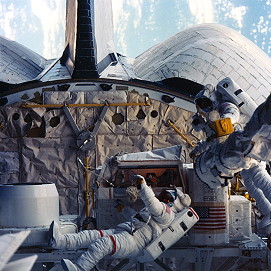
During his eight days in space in October 1984, Leestma served as “EV1” for the first U.S. spacewalk to involve a woman astronaut. Paired with Kathy Sullivan, he was tasked with evaluating hardware for the future refueling of satellites in low-Earth orbit, including Landsat-4 for the Department of Defense and NASA’s Gamma Ray Observatory (GRO). They used the Orbital Refueling System (ORS) to transfer 176 pounds (80 kg) of highly toxic hydrazine from one tank to another and spent three hours and 29 minutes in the vacuum of space. Shortly after his return from 41G, Leestma was named as a member of the 61E shuttle crew, planned for launch on 6 March 1986, which would have carried the ASTRO-1 payload of ultraviolet telescopes and performed observations of Halley’s Comet. At the time of the Challenger disaster, Mission 61E was just five weeks from flight. …
At the time of the Challenger disaster, Leestma had also been named to the crew of Mission 61N, a classified Department of Defense flight, scheduled for September 1986, just six months after 61E. Although both crews were ultimately stood down, the old 61N crew—Commander Brewster Shaw and fellow Mission Specialists Jim Adamson and Mark Brown, minus Pilot Mike McCulley and Manned Spaceflight Engineer (MSE) Frank Casserino—was reassigned in March 1988 to STS-28, the first post-Challenger flight of orbiter Columbia. McCulley’s place in the pilot’s seat was taken by Dick Richards. This Department of Defense mission was totally classified and influenced much of the crew’s training. “Sometimes you had to disguise where you were going,” said Leestma. “You’d file a flight plan in a T-38 … and go somewhere else, to try to not leave a trail for where you were going or what you were doing, who was the sponsor of this payload or what its capabilities were or what it was going to do. You had to be careful, all the time, of what you were saying.” The STS-28 mission took place in August 1989, after which Leestma served as deputy director of the Flight Crew Operations Directorate (FCOD) at JSC. In March 1992, he flew his third shuttle mission, STS-45, which carried the ATLAS-1 atmospheric and solar research payload. At the conclusion of his third and final shuttle flight, Leestma accrued more than 22 days in space.
He subsequently served as deputy chief and acting chief of the astronaut office and, in November 1992, was appointed as director of FCOD, a post he held until September 1998. This key post gave Leestma the responsibility for the selection and training of the crews for 41 shuttle flights and seven Mir missions, together with the selection of three new classes of astronauts and oversight of JSC Aircraft Operations, which included modifications of the T-38A to T-38N avionics. In his NASA oral history, Leestma recounted that he did not select shuttle crews on a flight-by-flight basis, but instead looked specifically at where the manifest was headed over perhaps an 18-month period and hand-picked individuals accordingly, based upon skills, talents, and expertise.
After six years at the helm of FCOD, Leestma was reassigned as deputy director of Engineering at JSC and, in August 2001, was named the JSC Project Manager for the Space Launch Initiative. During this period of his career, he also served as assistant program manager for the Orbital Space Plane (OSP), and in his latter years of NASA service he headed the JSC Exploration Programs Office—in support of the now-defunct Vision for Space Exploration (VSE)—and the JSC Advanced Planning Office, with responsibility for planning a strategy to tackle the challenges of the future, including the next human expeditions to the Moon and Mars. In his final role, Leestma led the Technical Transfer and Commercialization Efforts office at JSC. Illustrative of his experience and achievements, he has received no fewer than four NASA Exceptional Service Medals, two NASA Outstanding Leadership Medals, and was twice awarded the Presidential Rank of Meritorious Executive.
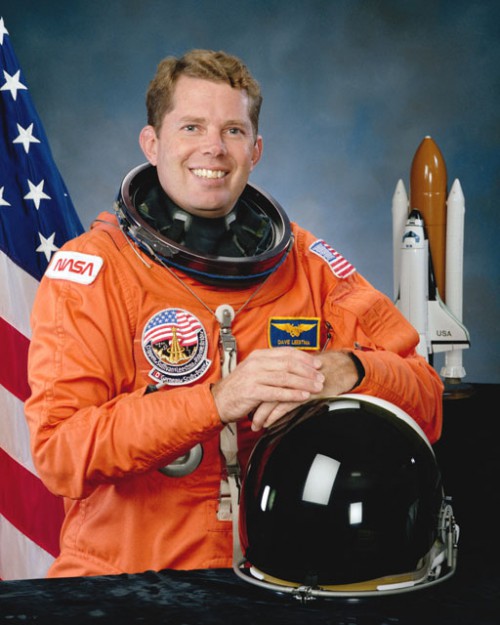
Also departing NASA is Andrew Sydney Withiel Thomas, a veteran of four space missions, including a long-duration stay aboard Russia’s Mir orbital station, a spacewalk, and membership of the first post-Columbia shuttle flight, STS-114. He also served as Payload Commander— the lead mission specialist, responsible for the successful conduct of all research objectives and scientific investigations—on his very first shuttle flight, STS-77 in May 1996. Thomas was born in Adelaide, South Australia, on 18 December 1951. His father would later recount that his son became fascinated by space exploration as a child and built a steady stream of model rockets from cardboard and plastic.
The young Thomas received much of his early schooling in Adelaide, then earned a first-class degree in mechanical engineering from the University of Adelaide in 1973 and stayed on to pursue his PhD. “As a young kid, growing up in Australia, the likelihood of me being selected as an astronaut was pretty thin,” Thomas told a NASA interviewer, “and I didn’t really consider it a very realistic possibility.” In his mind, the power of gaining a good education was the fundamental touchstone, coupled with a conscious effort to steer his subsequent career goals toward the space program. “I took steps in my career that would give me exposure to the right kinds of technical problems and technical experiences,” he said, “which would make me a good candidate for an astronaut position.”
In 1977, shortly before receiving his doctorate, Thomas became a research scientist with the Lockheed Aeronautical Systems Company, with responsibility for investigations into the control of fluid-dynamic instabilities and aircraft drag. He was promoted to Principal Aerodynamic Scientist in 1980 and accepted the headship of the Advanced Flight Sciences Department in 1983, overseeing a group which explored problems in advanced aerodynamics and aircraft flight testing. With a keen eye on joining NASA as an astronaut, Thomas became a naturalized U.S. citizen in December 1986, became the manager of Lockheed’s Flight Sciences Division the following year and in 1989 moved to Pasadena, Calif., to join the Jet Propulsion Laboratory (JPL), later rising to the position of supervisor of the Microgravity Research Group.
Three years later, in March 1992, he was selected by NASA as an astronaut candidate. His lifelong dream had been realized, and all due to the power of education. Thomas’ attitude was that education opened a path to many of his life experiences. “In fact,” he concluded, “it can open doors that you can’t even imagine and that would remain forever closed.” His wait for a flight assignment was a relatively long one; in fact, named as a crew member for STS-77 in June 1995, he was the last member of his class to draw a shuttle flight. Yet it was an ambitious one: The six-man crew conducted extensive scientific research aboard a commercial Spacehab laboratory, deployed and retrieved a Shuttle-Pointed Autonomous Research Tool for Astronomy (SPARTAN) free-flyer—equipped with the unique Inflatable Antenna Experiment (IAE)—and supported no fewer than four discrete rendezvous operations, more than any previous shuttle mission. Joining Thomas aboard STS-77 was Canadian astronaut Marc Garneau, who also accompanied Dave Leestma as a crew member on Mission 41G, more than a decade earlier.
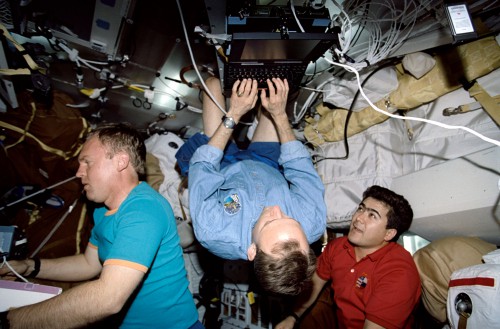
In the aftermath of STS-77, Thomas’ wait for another flight seemed to be a similarly long one. Yet it was to be surprisingly short, for in January 1997 he was sent to Star City, the cosmonauts’ training center, on the forested outskirts of Moscow, to train as the backup to fellow astronaut Dave Wolf for a four-month mission to Mir. Originally, Wolf expected to launch aboard STS-89 in January 1998 and return to Earth aboard STS-91 the following May. “The plan was I’d stay [in Star City] a year and Dave Wolf would go fly the last increment on Mir and I would come back and do something else,” Thomas reflected in his NASA oral history. “I actually undertook that mostly because I was curious about the Russian environment, not expecting that I would get a flight out of it.” When he told his family that he was going to Star City as a non-flying backup crew member, Thomas was initially greeted with some surprise.
Then, in June 1997 a Progress resupply craft impacted Mir during rendezvous, causing extensive damage to the space station, depressurizing its Spektr module, crippling its power supply, and prompting NASA to insist that all of its astronauts had to be certified in the Russian Orlan-M space suit. Wendy Lawrence, who was assigned to fly a four-month mission from September 1997 until January 1998, did not fit the suit, but had been granted a waiver on the condition that she was not called upon to perform an EVA. However, with EVAs involving U.S. astronauts now a distinct possibility, Lawrence was dropped from her flight and Wolf was accelerated into her former position. Likewise, Andy Thomas moved from his previous backup role into the prime slot for Wolf’s original mission.
When Thomas updated his family that he would actually be flying a long-duration mission to Mir, not long after a traumatic few months of fires and collisions and depressurizations and computer failures, “the conversation got decidedly quiet.” Yet his family trusted his judgement; they knew that Thomas was not the kind of person to immerse himself into something foolhardy or impetuous. He was launched aboard STS-89 in January 1998, and, although it was his second shuttle launch, it was one that he would never forget.
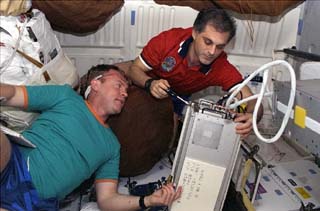
At five minutes before liftoff, Pilot Joe Edwards activated the APUs. “We could hear the units spinning up to speed, deep below us,” remembered Thomas, who was seated in Endeavour’s darkened middeck. “Then came the call to close and lock our visors and to initiate our oxygen flow, a protection in the event of a depressurisation during the climb-out … The three of us on the middeck shook hands together and wished ourselves well for the flight. Then the cabin became quiet. At six seconds before launch, a deep rumble started, shuddering the orbiter as its three engines were ignited and run up to full speed … ” Amidst the din, Thomas heard over the intercom as Edwards reported “Three at 104!” to verify that all three engines were running at full power. At T-0, the Solid Rocket Boosters (SRBs) ignited and STS-89 roared spectacularly into the darkened Florida sky, precisely on time. Even though he had no windows, Thomas said later, “you did not need a window to know what was happening!”
Two days later, on 24 January 1998, Thomas arrived at Mir and was faced with initial difficulty when transferring his custom-molded seat liner from the shuttle over to the Soyuz TM-26 spacecraft. It became clear during a pressure check that his Sokol (“Falcon”) launch and entry suit did not fit; its torso was too short, even though it had been checked and verified before launch. “The problem is I cannot pull it up over my shoulders,” Thomas reported. “It’s either not sized correctly or there’s not been adequate allowance for the growth of my height in zero-gravity. And I suspect it’s probably both.” He tried Dave Wolf’s suit for size and successfully passed a pressure check, but the problem was that when it was under pressure the arms extended about six inches (15 cm) from the ends of Thomas’ hands. “It’s basically unusable,” he said, “in that configuration, at least.”
Since Thomas would need the Sokol in the event of an emergency evacuation aboard Soyuz TM-26, it was imperative that the issue was resolved before he could become a member of Mir’s crew. For that reason, Wolf spent an extra night aboard the space station and the Americans’ seat liners were temporarily swapped back. Next morning, aided by Mir commander Anatoli Solovyov, the two Americans set to work modifying Wolf’s suit. “The straps on the legs and the underarms are … cinched up, very tight, and stitched that way,” Thomas explained later, “so we can’t just release them. We actually have to cut the non-critical stitching.” They detached internal straps at the shoulders and groin of Wolf’s suit, which resized it to enable a comfortable fit under both pressurized and non-pressurized conditions, and both U.S. and Russian officials granted their approval for the crew exchange to officially go ahead.
There was some talk in the media that Russian Flight Director Viktor Blagov was incensed at the suggestion that his space suit tailors had screwed up in some fashion. “There were no objective problems with his space suit,” Blagov is said to have exploded, as quoted by CBS News journalist Bill Harwood. “The astronaut [Thomas] simply turned out to be somewhat capricious. For us, it’s a symptom that the astronaut may remain capricious all through the flight.” However, Jim van Laak, NASA’s Shuttle-Mir deputy program manager, flatly denied that Blagov had made such a remark and repeatedly asserted that the Russians had “great confidence in Andy.” In fact, Thomas’s stay aboard the space station would be one of the smoothest of the entire Shuttle-Mir program. By the time he returned to Earth on 12 June 1998, he had spent almost 141 days in orbit, which, in addition to his 10 days from STS-77, made him the fourth most experienced U.S. space traveler at that time, eclipsed by Shannon Lucid, Mike Foale, and John Blaha.
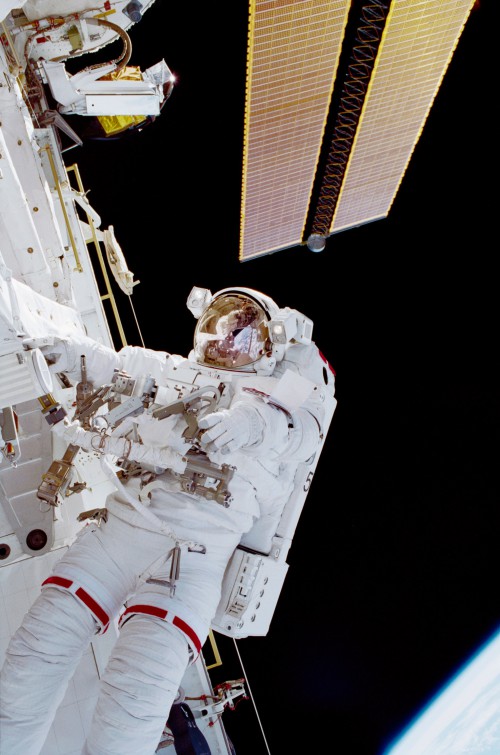
Thomas’s final two shuttle missions were similarly dramatic. In March 2001, he served aboard STS-102, a 13-day flight to the fledgling International Space Station (ISS), which exchanged the Expedition One and Two crews and delivered equipment and supplies aboard the first Italian-built Multi-Purpose Logistics Module (MPLM). During the course of the mission, Thomas and crewmate Paul Richards performed a six-hour EVA to transfer the Early Ammonia Servicer (EAS) to the station’s P-6 truss, install the External Stowage Platform, and deliver and replacement Pump Flow Control System.
Following STS-102, in August 2001, Thomas was named as deputy chief of the astronaut office, a position which he held until the end of 2003, after the tragic loss of Columbia in the STS-107 disaster. In November 2003, he was appointed as one of three additional mission specialists for STS-114, the first post-Columbia shuttle flight. Originally, STS-114 had been scheduled for March 2003 and would have included a four-person “core” crew—Commander Eileen Collins, Pilot Jim “Vegas” Kelly, and Mission Specialists Steve Robinson and Soichi Noguchi—as well as exchanging the Expedition Six and Seven crews. However, with the inclusion of new flight safety tests and systems, including a sensor-laden inspection boom to observe the shuttle’s flight surfaces for damage, it was considered prudent to expand the STS-114 crew to seven “dedicated” members. Rescheduled for September 2004, the Return to Flight mission was extensively delayed and eventually launched in July 2005. It lasted almost 14 days and marked Andy Thomas’ final space mission. Across his four flights outside the atmosphere, he had accrued a total of 177 days in orbit.
With his retirement from NASA, Thomas completes more than two decades of service as an astronaut. “Andy is an extraordinary researcher and astronaut who has done it all in his 22 years as a NASA astronaut,” said Janet Kavandi, the current director of FCOD. “In his 177 days in space over four missions, Andy served as the payload commander for a dedicated research mission, lived aboard the Russian Mir space station, conducted a spacewalk during an International Space Station assembly mission and served a vital role as a crew member on our crucial Return to Flight mission, STS-114, following the tragic Columbia accident. Since his last flight, Andy has helped shape NASA’s future through his tireless work supporting the development of future exploration technology. We will miss him deeply.”
Both Dave Leestma and Andy Thomas have contributed enormously to the U.S. space program for more than three decades and have played a significant role, both as astronauts and in NASA management, in a number of key shuttle missions. Men of their caliber remain difficult to replace, and the AmericaSpace team wishes them every success in the future.
Want to keep up-to-date with all things space? Be sure to “Like” AmericaSpace on Facebook and follow us on Twitter: @AmericaSpace




Hi Ben,
i really enjoy your articles, but feel especially good about this one, as i too come from Adelaide and we are very proud of Andy here.
Thanks for the comment, Joe.